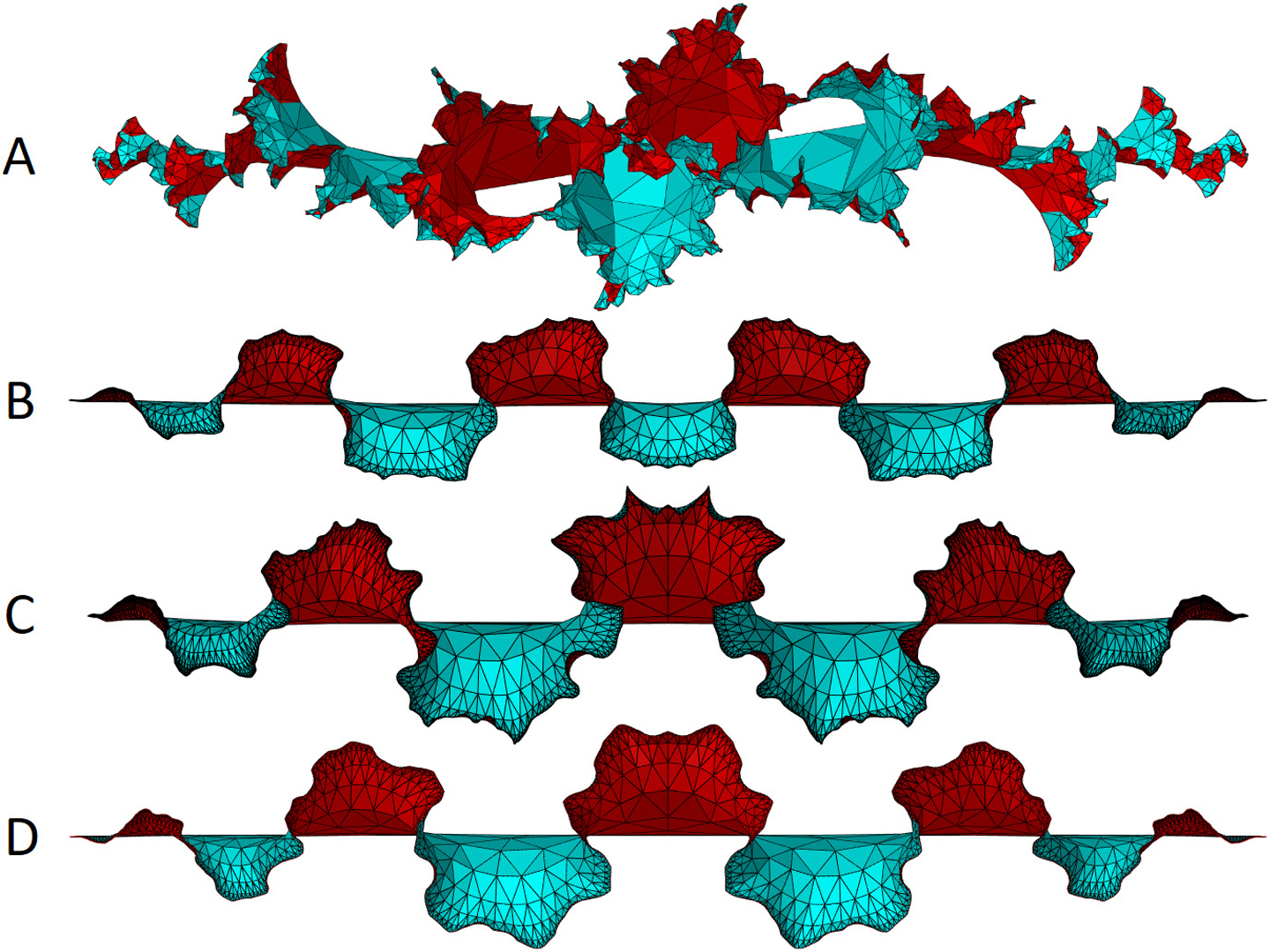“Simulation of Emergent Rippling on Growing Thin-Shells” by Huang and Stavness
Conference:
Type(s):
Entry Number: 70
Title:
- Simulation of Emergent Rippling on Growing Thin-Shells
Presenter(s)/Author(s):
Abstract:
INTRODUCTION
Many thin tissues, such as leaves and flower petals, exhibit rippling and buckling patterns along their edge as they grow (Figure 1). Experiments with plastic materials have replicated the rippling patterns found in nature and shown that such patterns exhibit a fractal quality of ripples upon ripples — a so called “buckling cascade” [Eran et al. 2004]. Such patterns are influenced by many physical mechanisms, including stress forces, physical properties of materials (e.g., stiffness), and space constraints [Prusinkiewicz and Barbier de Reuille 2010]. Physics-based computer animation that produces emergent rippling patterns on thin surface can improve the realism of virtual flowers and leaves, and also help to explain which physical mechanisms are most important for controlling the morphology of tissues with buckling cascades.
Simulating the mechanics of thin, growing biological tissues is a challenging task as it requires the integration of many physics simulation components. In particular, growing tissue models require the simulation of thin structures, elastic deformations, inelastic “growth” deformations, non-homogeneous materials, morphogen diffusion, collision detection, remeshing, and other components. The majority of thin structure simulation methods in computer graphics only consider elastic deformations and isotropic materials.
Along with the difficulty of incorporating all the components required for growth, there is a limitation in the current experiments where the thin structure of growing tissue are modeled using either spring-masses [Prusinkiewicz and Barbier de Reuille 2010] or solid finite elements [Kennaway et al. 2011]. In a spring-mass model, it is generally less stable, does not accurately represent continuum mechanics like finite-element analysis, and does not intrinsically account for bending resistance in a model with a single layer of springs. While solid finite elements can be used instead of spring-masses to overcome these shortcomings, these volumetric elements have their own limitations when representing thin structures. While a thin structure can be constructed using a single layer of volumetric elements with a small height each, the width and length of each element also needs to be small to maintain well conditioned elements, reducing the risk of encountering highly distorted or inverted elements. However, many of these smaller elements would be needed to fill the thin structure which greatly increases the computational complexity of the model.
We propose an interactive tissue growth simulation method that currently integrates thin-shell finite elements with elastic and inelastic deformation to represent the elasticity and permanent deformation of growing tissue. We show that our growing thin-shell simulations can produce spontaneous emergent buckling cascades. We compare our growing thin-shell formulation to matched springmass and solid finite element models, and also illustrate how tissue thickness alters the pattern of tissue rippling.
References:
- P Betsch, F Gruttmann, and E Stein. 1996. A 4-node finite shell element for the implementation of general hyperelastic 3D-elasticity at finite strains. Computer Methods in Applied Mechanics and Engineering 130, 1-2 (1996), 57–79.
- CJ Cyron, JS Wilson, and JD Humphrey. 2017. Constitutive formulations for soft tissue growth and remodeling. In Biomechanics of Living Organs. Elsevier, 79–100.
- Sharon Eran, Michael Marder, and Harry L Swinney. 2004. Leaves, flowers and garbage bags: making waves. American Scientist 92, 3 (2004), 254.
- Richard Kennaway, Enrico Coen, Amelia Green, and Andrew Bangham. 2011. Generation of diverse biological forms through combinatorial interactions between tissue polarity and growth. PLoS computational biology 7, 6 (2011), e1002071.
- JE Lloyd, I Stavness, and S Fels. 2012. ArtiSynth: A fast interactive biomechanical modeling toolkit combining multibody and finite element simulation. In Soft Tissue Biomech Modeling for Computer Assisted Surgery. Springer, 355–394.
- Przemyslaw Prusinkiewicz and Pierre Barbier de Reuille. 2010. Constraints of space in plant development. Journal of experimental botany 61, 8 (2010), 2117–2129.
Keyword(s):
Acknowledgements:
We thank Przemyslaw Prusinkiewicz, Mikolaj Cieslak, and John Lloyd for their helpful discussions on this work. This research was undertaken thanks in part to funding from the Canada First Research Excellence Fund.





